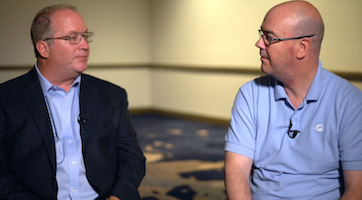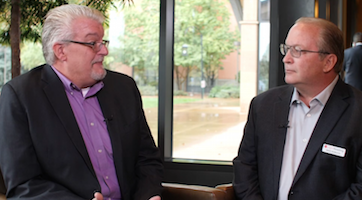Comments
Michelle
12/30/2016 1:32:52 PM
User Rank Platinum
In-house application
Moving fully to cloud-based services can disrupt workflows in many areas. Adapting over time should prove to be win for many departments within the organization. The introduction of the OWS lab is especially interesting. I look forward to reading more about Huawei's innovations in the coming years.
elizabethv
12/31/2016 7:30:30 AM
User Rank Platinum
Re: In-house application
@Michelle - I agree, moving to fully cloud-based services can cause a lot of problems. But I also think their initiative of getting all employees using cloud-based services all the time will actually help in the long run. But getting employees not only actively involved, but fully used to working in the environment they are creating and a part of will not only create buy-in, but also will benefit customers as well.
Michelle
12/31/2016 11:00:24 AM
User Rank Platinum
Re: In-house application
@elizabeth You're right, they could have taken a different approach that didn't involve a transition period for employees. Choosing a more inclusive option should benefit them as they move to the cloud.
Re: In-house application
Agree with you all.
It surely is a good idea to consider phased approach to move things to cloud instead of opting for all at once move.
Stats
Two years ago, we set a goal: We had to develop at least 3,000 internal IT experts. Though we encountered great difficulties throughout this process, we raised the bar for the second year -- we had to develop 10,000 IT experts. Now, our goal is to develop 30,000 skilled IT experts.
These are interesting stats. Very impressive trend to notice. IT skills an dexperise is undeniably an absolute critical need in these changing times.
Move to Cloud
We think IT era and cloud era will be the same in this respect. How can we gradually move to the cloud? To be frank, nobody can say for certain what the process is. But we can try our best and, step by step, we will certainly find the right solution.
Makes sense, IT era and Cloud era are very similar in aspect of progressive growth. There is no har set or defined peocess per say to move to cloud. A company can plan the move agile way - step by step or phased approach.
Michelle
12/31/2016 7:54:00 PM
User Rank Platinum
Re: In-house application
Can you imagine the mess it would create if they had decided to move to cloud with little forethought? Rushing into a new technology or workflow is usually a bad idea.
elizabethv
1/6/2017 10:26:28 AM
User Rank Platinum
Re: In-house application
@Michelle - They also could have created a large employee backlash. While most likely would have followed suit because let's face it, finding new jobs anymore isn't easy, especially ones with the pay you are accustomed to. Even if employees would have chosen to deliberately complete tasks just a little slower than usual, or not do something exactly the way they were asked. Even little things can end up making a big impact. In the end it could have had a very negative perception on the part of the employees, who even if they might not leave immediately, might always be just a little less satisfied in their jobs, a little more willing to look elsewhere for employment. Thus creating turnover, which is expensive for all companies.
JohnBarnes
1/11/2017 10:30:00 PM
User Rank Platinum

Re: Move to Cloud
I would say you do the move to the cloud the same way you learn to walk in tai chi chuan (which, among many other things, is a method of practicing to improve your kung fu). You learn to move each foot in a rhythm of pick up-extend-place-shift, i.e. while balanced on one foot, you reach out with the other, make contact with the new place you intend to stand, and only once you know the ground is good under you do you shift your weight.
So the answer is, at first you keep whatever absolutely must work at home on your own servers, and extend a wholly optional pathway into the cloud (pick up). Then you grow that pathway as far as it can go without difficulty (extend). Then you determine what benefits can flow back and forth along that pathway (place). And finally--only then--you actually migrate functions to the cloud, gradually losing your local-server mirroring. (shift).
The metaphor goes further: Of course, you learn to do that very slowly in several different tai chis (despite what the folks in St. Cloud and your local yoga studio may tell you, there are hundreds of different pais (forms) of tai chi). Eventually you do it so automatically that you are hardly aware you have learned to maintain your balance and your ability to retreat constantly; you move as fast as a kung fu master but with perfect balance.
So I suspect the first advances into the cloud will be slow and hesitant, but the last steps of "cloudization" will go like lightning (and just possibly kick us all in the head before we know what's happening.)

DHagar
1/13/2017 7:36:42 PM
User Rank Platinum
Re: Move to Cloud
@John Barnes. This is an excellent article and most clearly provides definitions of the distinctions that need to be understood in the cloud era.
I find your analogy as an excellent further insight into the "transformational" and "learning" process through adoption. It truely must be an exercise and discovery if it is going to be successful; and if the customers are going to gain value.
Great contribution!
|
|

Italy's 5G auction could exceed a government target of raising €2.5 billion ($2.9 billion) after attracting interest from companies outside the mobile market.
The emerging-markets operator is focusing on the humdrum business of connectivity and keeping quiet about some of its ill-fated 'digitalization' efforts.
Three UK has picked Huawei over existing radio access network suppliers Nokia and Samsung to build its 5G network.
Vendor says that it's its biggest 5G deal to date.
Verizon skates where the puck is going by waiting for standards-based 5G devices to launch its mobile service in 2019.
Orange has been one of the leading proponents of SDN and NFV. In this Telco Transformation radio show, Orange's John Isch provides some perspective on his company's NFV/SDN journey.
10/16/2017
Huawei Network Transformation Seminar
The adoption of virtualization technology and cloud architectures by telecom network operators is now well underway but there is still a long way to go before the transition to an era of Network Functions Cloudification (NFC) is complete.

The Small Cell Forum's CEO Sue Monahan says that small cells will be crucial for indoor 5G coverage, but challenges around business models, siting ...

People, strategy, a strong technology roadmap and new business processes are the key underpinnings of Telstra's digital transformation, COO Robyn ...

Eric Bozich, vice president of products and marketing at CenturyLink, talks about the challenges and opportunities of integrating Level 3 into ...

Epsilon's Mark Daley, director of digital strategy and business development, talks about digital transformation from a wholesale service provider ...

Bill Walker, CenturyLink's director of network architecture, shares his insights on why training isn't enough for IT employees and traditional ...
All Videos
|
 On-the-Air Thursdays Digital Audio
On-the-Air Thursdays Digital Audio Special Huawei Video
Special Huawei Video

















